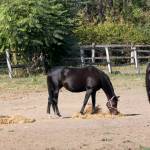Botulism: Keep Your Horses Safe

Botulism can kill your horse in 24 hours. That’s the bad news. The good news is that you can take simple steps to lower the risk of botulism for your horses, and even if a horse is affected, early treatment is often successful.
Clostridium botulinum bacteria are widespread in soil, bird droppings, and decaying animal carcasses. Spores can remain inactive for long periods of time, but with the proper conditions of moisture and minimal oxygen levels, they can activate to a dangerous state. Horses that eat from large round hay bales may ingest these bacteria if moisture in the center of the bale has provided the right environment for proliferation. Keeping hay off the ground, feeding only dry hay, discarding any damp or moldy hay, and avoiding the use of round bales are ways to decrease the risk for horses.
Square bales that are produced from well-dried grass are somewhat safer but can also contain botulin toxin if the hay rake has picked up the bodies of mice or other animals. As these carcasses decay within the bale, toxins spread into the surrounding hay and may be eaten by horses, causing signs of botulism such as drooping lips, lowered head carriage, and difficulty swallowing. Horses that ingest larger doses of toxin can develop body-wide muscle tremors, inability to stand, and labored breathing.
Fresh vegetation quickly begins to decay after cutting, providing a place for botulin bacteria to thrive. For this reason, damp grass clippings should not be offered to horses, and piles of vegetation that have washed up on creek banks are also dangerous for horses to eat.
A vaccine is available to protect horses against some types of botulism. Veterinarians can guide owners in deciding if the vaccination is advisable for their horses.








